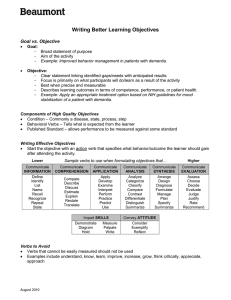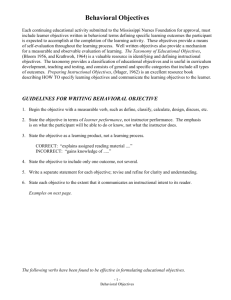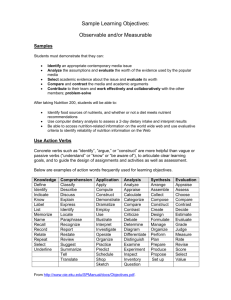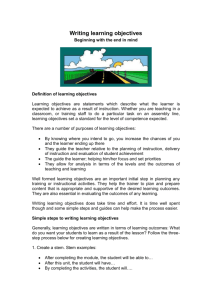Creating and Writing Learning Objectives guide
advertisement
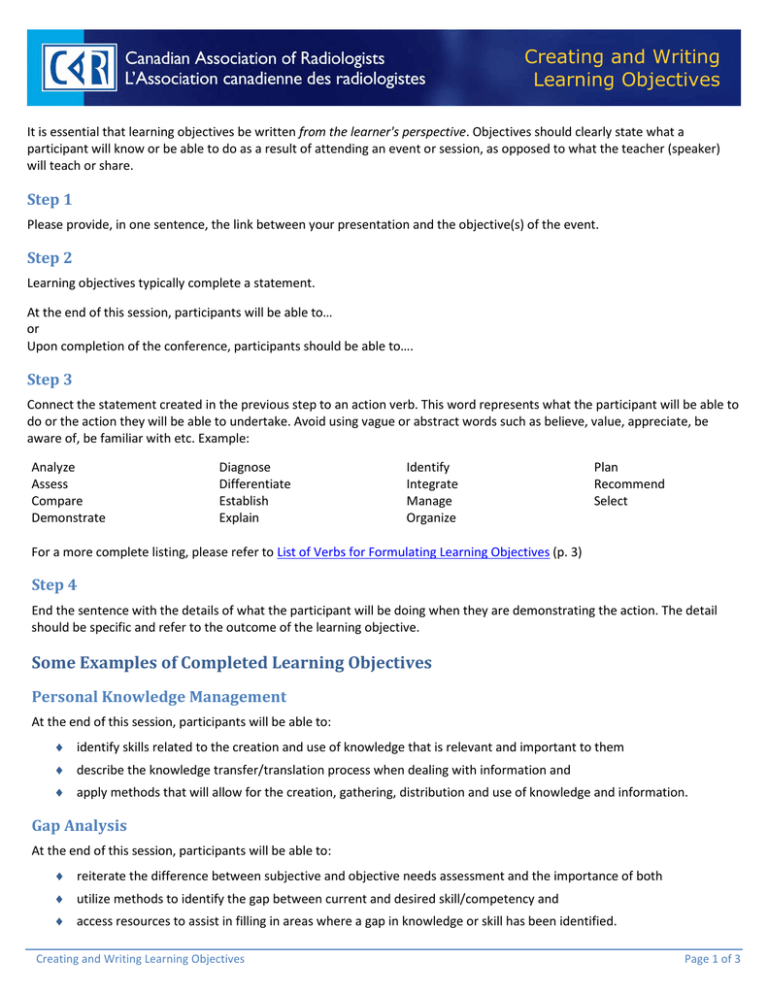
Creating and Writing Learning Objectives It is essential that learning objectives be written from the learner's perspective. Objectives should clearly state what a participant will know or be able to do as a result of attending an event or session, as opposed to what the teacher (speaker) will teach or share. Step 1 Please provide, in one sentence, the link between your presentation and the objective(s) of the event. Step 2 Learning objectives typically complete a statement. At the end of this session, participants will be able to… or Upon completion of the conference, participants should be able to…. Step 3 Connect the statement created in the previous step to an action verb. This word represents what the participant will be able to do or the action they will be able to undertake. Avoid using vague or abstract words such as believe, value, appreciate, be aware of, be familiar with etc. Example: Analyze Assess Compare Demonstrate Diagnose Differentiate Establish Explain Identify Integrate Manage Organize Plan Recommend Select For a more complete listing, please refer to List of Verbs for Formulating Learning Objectives (p. 3) Step 4 End the sentence with the details of what the participant will be doing when they are demonstrating the action. The detail should be specific and refer to the outcome of the learning objective. Some Examples of Completed Learning Objectives Personal Knowledge Management At the end of this session, participants will be able to: ♦ identify skills related to the creation and use of knowledge that is relevant and important to them ♦ describe the knowledge transfer/translation process when dealing with information and ♦ apply methods that will allow for the creation, gathering, distribution and use of knowledge and information. Gap Analysis At the end of this session, participants will be able to: ♦ reiterate the difference between subjective and objective needs assessment and the importance of both ♦ utilize methods to identify the gap between current and desired skill/competency and ♦ access resources to assist in filling in areas where a gap in knowledge or skill has been identified. Creating and Writing Learning Objectives Page 1 of 3 Canadian Association of Radiologists Writing Learning Objectives Every decision you make about your lecture/workshop should depend on the learning objectives for your intended audience. Learning objectives should be clearly stated for each learning activity, to inform your audience about what they should expect. Thus, the success of your lecture/workshop will be measured by how well you achieve these objectives. A learning objective should be specific, short-range, and relatively concrete. It is not a mere description of the content of your presentation, but instead outlines what a learner will be able to do differently (what learner behaviour will change) if they attend your presentation. One good way to state learning objectives is to begin with the phrase “At the end of this lecture/workshop, the learner will be able to…” This phrase is followed by an “action” verb that describes what the learner will be able to do differently. Learning objectives can focus on knowledge, skills, attitudes, and practice (long-term future behaviour). For objectives relating to knowledge, “action” verbs could include: list, describe, explain, identify, categorize, document, etc. If the objectives are loftier, aiming for an ability to critically analyze knowledge, the verbs could include: debate, critique, distinguish, compare, evaluate, etc. For objectives relating to skills, the verbs could include: solve, demonstrate, operate, supervise, diagnose, etc. For objectives relating to attitudes, the verbs could include: accept, value, support, resist, consider, manifest care or concern about, etc.. For objectives relating to practice, the verbs are similar to those for skills, but the focus is on long-term behaviour. It is also useful to specify the expected performance levels and conditions for each objective. For example, a brief workshop on psychotherapy would unlikely lead to a complete mastery of skills. However, it might lead to an awareness or appreciation of the skills, or competence in a specific component or skill. Here are some examples of effective learning objectives written for a recent conference on “Maintaining Professional Boundaries”: 1. …participants will be able to identify at least four types of sexual misconduct. 2. …participants will be able to describe transference, countertransference, and list three bases for the power differential in the psychotherapy relationship. 3. …participants will be able to describe administrative safeguards which can limit the risk of unprofessional conduct. By Ivan Silver and John Teshima Adapted from a document entitled “Guidelines for Conducting Workshops and Seminars” ©February 2002, Richard Tiberius and Ivan Silver, Department of Psychiatry, University of Toronto Creating and Writing Learning Objectives Page 2 of 3 Canadian Association of Radiologists List of Verbs for Formulating Educational Objectives The following verbs have been found to be effective in formulating educational objectives: 1. Those that communicate knowledge: Information: cite count define describe draw identify indicate list name point quote read recite recognize record relate repeat select state summarize tabulate tell trace update write Comprehension: assess associate classify compare compute contrast demonstrate describe differentiate discuss distinguish estimate explain express extrapolate interpolate interpret predict report restate review translate Application: apply calculate choose complete demonstrate develop employ examine illustrate interpolate interpret locate match operate order practice predict prescribe relate report restate review schedule select sketch solve translate treat use utilize Analysis: analyze appraise contract contrast criticize debate deduce detect diagram differentiate distinguish experiment infer inspect inventory measure question separate Synthesis: arrange assemble collect combine compose construct create design detect document formulate generalize integrate manage organize plan prepare prescribe produce propose specify validate critique decide determine estimate evaluate grade judge measure rank rate recommend revise score select test internalize listen massage measure operate palpate pass project record visualize write plan realize reflect revise transfer Evaluation: appraise assess choose compare 2. Those that impart skills: demonstrate diagnose diagram empathize hold integrate 3. Those that convey attitudes: acquire consider exemplify modify These words are better avoided (often used but are open to many interpretations): appreciate believe have faith in know learn understand Continuing medical education: a primer, Rosof, A. B., & Felch, W .C. Copyright © 1992 by Praeger. Reproduced with permission of Greenwood Publishing Group, Inc., Westport, CT. Creating and Writing Learning Objectives Page 3 of 3
